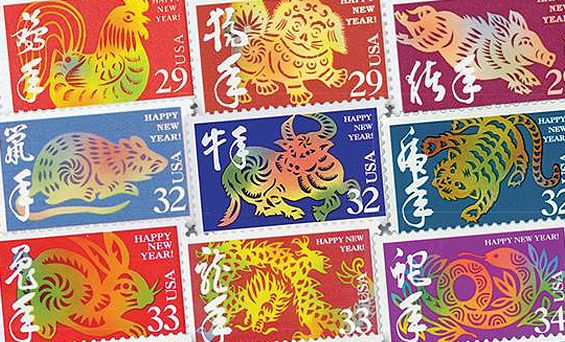Lunar New Year Series
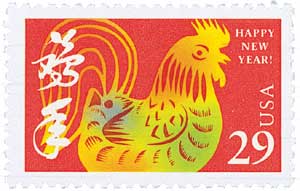
Year of the Rooster
For the first time ever, the Postal Service issued a special stamp for the New Year in 1992. Printed in a new and experimental format; panes of 20 that are four-stamps-wide and five-stamps-deep, the stamp depicts a stylized rooster, referring to the Chinese year which began on January 23, 1993.
Based on Chinese paper cut-outs, the rooster stamp was popular. In fact, the post office servicing San Francisco’s Chinatown sold nearly two million stamps in the month of January alone. In 1994 the series continued with the issue of this stamp commemorating the upcoming New Year, the Year of the Dog.
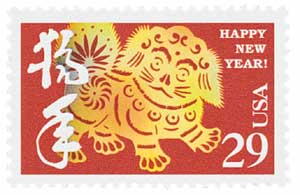
Year of the Dog
Artist Clarence Lee of Honolulu, Hawaii based his design on the Pekingese, the royal dog of China. Regarded as sacred, the dog was kept as royal dog of the Imperial Palace, and could only be owned by those of royal blood. Following the British invasion of Beijing (Peking) in 1860, the Pekingese was brought to England.
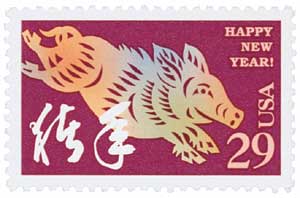
Year of the Boar
According to legend, the order of the twelve animals was determined by Buddha himself. Concerned for the welfare of the Chinese nation, he called all the animals in the kingdom to a meeting, but only 12 beasts showed up. For their loyalty, Buddha honored each of the twelve animals, in the order of their arrival, with a year in the Chinese zodiac – beginning with the rat and ending with the boar.

Year of the Rat

Year of the Ox
Individuals born during the Year of the Ox are trustworthy, dependable, and conscientious. Known to have strong ideas, they are also said to be stubborn and jealous. Through hard work and fortitude however, they are likely to prosper.

Year of the Tiger
People born during tiger years are believed to be courageous and strong, as well as generous and sensitive. They may be self-assured, but can also be hasty and unpredictable. Tigers are leaders and protectors; they are noble and honorable.

Year of the Hare

Year of the Dragon
The origin of the New Year Festival is too old to trace. But according to one legend, a man-eating-dragon called Nian (“year in Chinese) terrorized China until an old man convinced it to stop. People hung red decorations at year’s end to scare Nian away just incase it returned. Today, Chinese people still put up red decorations and set off firecrackers to scare Nain and other evil spirits away.

Year of the Snake
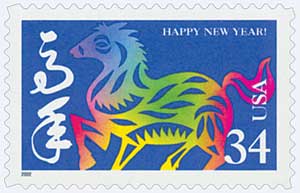
Year of the Horse
Those born in the Year of the Horse are said to be outgoing, athletic, confident, hard-working, and independent.
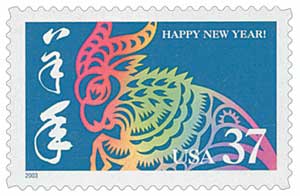
Year of the Ram
Those born in the Year of the Ram are said to be gentle, kind-hearted, elegant, wise, shy, charming, artistic, and fond of nature.

Year of the Monkey
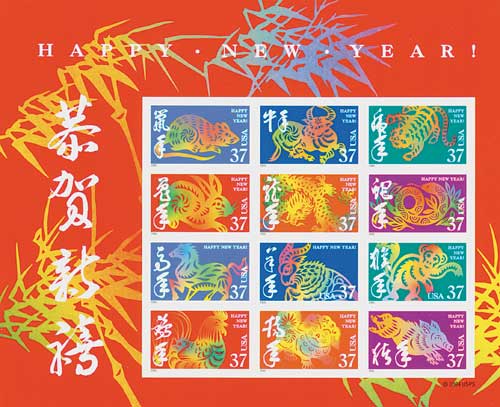
Chinese New Year Two-Sided Pane
In 2005, the U.S. Postal Service gathered all the Lunar New Year designs onto one souvenir sheet. At the 2005 first-class rate of 37¢, however, the cost of the sheet would have been $4.44 for 12 stamps. The number four is an unlucky number in Asia. The Postal Service decided to make the sheet double-sided. The total price of the sheet of 24 then became $8.88; eight is a lucky number in Asia.

Chinese New Year

